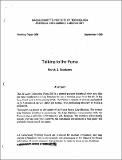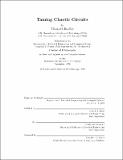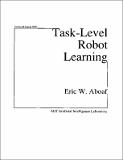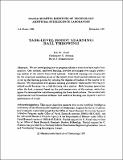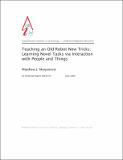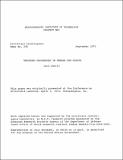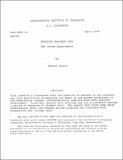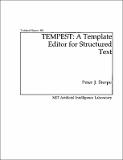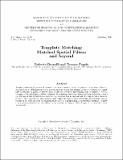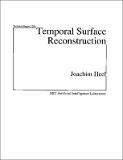Browsing Artificial Intelligence Lab Publications by Title
Now showing items 1615-1634 of 1835
-
Tactile Recognition and Localization Using Object Models: The Case of Polyhedra on a Plane
(1983-03-01)This paper discusses how data from multiple tactile sensors may be used to identify and locate one object, from among a set of known objects. We use only local information from sensors: (1) the position of contact ... -
Talking to the Puma
(MIT Artificial Intelligence Laboratory, 1982-09)The AI Lab's Unimation Puma 600 is a general-purpose industrial robot arm that has been interfaced to a Lisp Machine for use in robotics projects at the lab. It has been fitted with a force-sensing wrist. The Puma is capable ... -
Taming Chaotic Circuits
(1992-09-01)Control algorithms that exploit chaotic behavior can vastly improve the performance of many practical and useful systems. The program Perfect Moment is built around a collection of such techniques. It autonomously ... -
Task and Object Learning in Visual Recognition
(1991-01-01)Human performance in object recognition changes with practice, even in the absence of feedback to the subject. The nature of the change can reveal important properties of the process of recognition. We report an ... -
Task-Level Robot Learning
(1988-08-01)We are investigating how to program robots so that they learn from experience. Our goal is to develop principled methods of learning that can improve a robot's performance of a wide range of dynamic tasks. We have ... -
Task-Level Robot Learning: Ball Throwing
(1987-12-01)We are investigating how to program robots so that they learn tasks from practice. One method, task-level learning, provides advantages over simply perfecting models of the robot's lower level systems. Task-level ... -
Taxonomic Syntax for First-Order Inference
(1989-06-01)Most knowledge representation languages are based on classes and taxonomic relationships between classes. Taxonomic hierarchies without defaults or exceptions are semantically equivalent to a collection of formulas ... -
Teacher's Guide for Computational Models of Animal Behavior
(1977-04-01)This is an experimental curriculum unit which suggests how the computational perspective can be integrated into a subject such as elementary school biology. In order to illustrate the interplay of computer and non-computer ... -
Teaching an Old Robot New Tricks: Learning Novel Tasks via Interaction with People and Things
(2003-06-20)As AI has begun to reach out beyond its symbolic, objectivist roots into the embodied, experientialist realm, many projects are exploring different aspects of creating machines which interact with and respond to the world ... -
Teaching Children Thinking
(1971-10-01)This paper is dedicated to the hope that someone with power to act will one day see that contemporary research on education is like the following experiment by a nineteenth century engineer who worked to demonstrate that ... -
Teaching Children to be Mathematicians vs. Teaching About Mathematics
(1971-07-01)Being a mathematician is no more definable as 'knowing' a set of mathematical facts than being a poet is definable as knowing a set of linguistic facts. Some modern math ed reformers will give this statement a too easy ... -
Teaching of Procedures-Progress Report
(1972-10-01)The idea of building a programmer is very seductive in that it holds the promise of massive bootstrapping and thus ties in with many ideas about learning and teaching. I will avoid going into those issues here. It is ... -
Teaching Procedures in Humans and Robots
(1970-09-01)Analysis of the structure of procedures is central to the foundations of problem soling. In this paper we explore three principle means for teaching procedures: telling, canned loops, and procedural abstraction. The ... -
Teaching Teachers LOGO: The Lesley Experiments
(1976-04-01)This research is concerned with the question of whether or not teachers who lack specialized backgrounds can adapt to and become proficient in the technically complex, philosophically sophisticated LOGO learning ... -
Teaching the Computer to Add: An Example of Problem-Solving in an Anthropomorphic Computer Culture
(1976-12-01)Computers open up new ways to think about knowledge and learning. Learning computer science should draw upon and feed these new approaches. In a previous paper called "Leading a Child to a Computer Culture" I discuss ... -
Television Camera-To-Computer Adapter: PDP-6 Device 770
(1965-01-01)The TVA (Television Adaptor) is a data-input device just completed. Any standard Closed-Circuit Television Camera can be connected to the PDP-6, without modification, by a single BNC connector. Then a simple program can ... -
TEMPEST -- A Template Editor for Structured Text
(MIT Artificial Intelligence Laboratory, 1984-05)This paper proposes an editing tool named TEMPEST (TEMPlate Editor for Structured Text) whose goal is to extend a text editing environment by using templates to incorporate into it some knowledge of the structure of the ... -
TEMPEST: A Template Editor for Structured Text
(1985-06-01)TEMPEST is a full-screen text editor that incorporates a structural paradigm in addition to the more traditional textual paradigm provided by most editors. While the textual paradigm treats the text as a sequence of ... -
Template Matching: Matched Spatial Filters and Beyond
(1995-10-01)Template matching by means of cross-correlation is common practice in pattern recognition. However, its sensitivity to deformations of the pattern and the broad and unsharp peaks it produces are significant drawbacks. This ... -
Temporal Surface Reconstruction
(1991-05-01)This thesis investigates the problem of estimating the three-dimensional structure of a scene from a sequence of images. Structure information is recovered from images continuously using shading, motion or other visual ...

